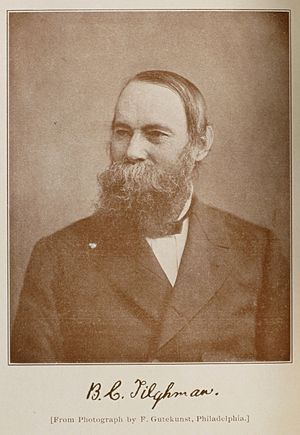Benjamin Chew Tilghman facts for kids
Benjamin Chew Tilghman (born October 26, 1821 – died July 3, 1901) was an American soldier and a clever inventor. He is most famous for inventing a special process called sandblasting.
Contents
Early Life and Learning
Benjamin was born in Philadelphia, Pennsylvania, on October 26, 1821. He was the third child of Benjamin and Anne Marie Tilghman. His family had a history of important people, including a surgeon and a Chief Justice.
He went to Bristol College and then the University of Pennsylvania. He finished his law degree in 1839, but he never actually worked as a lawyer. Before the American Civil War, he and his brother, Richard, traveled a lot in Europe. They visited many science labs, chemical factories, and mills, which probably sparked his interest in inventions.
Soldier in the Civil War
When the American Civil War began, Benjamin Tilghman joined the army as a Captain. He quickly rose through the ranks, becoming a Colonel and leading the 29th Pennsylvania Volunteer Infantry. In 1863, he was badly hurt in his leg during the Battle of Chancellorsville and had to go home to get better.
After he recovered, he became a Colonel again, this time leading the 3rd United States Colored Troops. These were regiments made up of African American soldiers. In 1865, he was given an honorary promotion to Brigadier General for his excellent service.
Inventing Sandblasting
There's a story that Benjamin Tilghman got the idea for sandblasting while he was a general in the army. He supposedly saw how strong winds in the desert blew sand against windows, making them rough or etched. This observation gave him the idea for his invention.
Around 1870, he invented the sandblasting process. He got a patent for it in the United States (US patent 108,408). A patent is like an official document that says you invented something and no one else can copy it without your permission. His patent explained many ways sandblasting could be used, like making files sharper, carving designs into bottles, cleaning dirty boilers, or bringing out the natural look of wood. Later that same year, he also got a patent in the United Kingdom.
In 1871, his invention won the Great Medal of Honor at an exhibition in New York. Soon after, he also received the Elliott Cresson Medal from the Franklin Institute, which is a very respected award for scientific achievements. He kept improving his sandblasting technique. In 1877, he got another patent for a way to sharpen files, which he called "Liquid Grindstone."
Starting Businesses
Benjamin Tilghman started his first company with his brother in Philadelphia. They made special iron shot (small metal balls) used in the stone industry. Around 1879, Benjamin moved to London, England, and started a new company called Tilghman's Patent Sand Blast Co. This company used his method for sharpening files and rasps.
He later moved to Sheffield, which was a big center for making steel in England. Then he moved to Altrincham in Cheshire around 1885. He invested in a machine company there. In 1879, he opened a new factory in Broadheath, Altrincham. This factory became the main place for the sandblasting industry in Great Britain. This company, now called Wheelabrator Group, is still in business today!
Other Cool Inventions
While he was busy with sandblasting, Benjamin Tilghman also worked on other things. He invented a way to make iron shot by pouring melted metal onto a spinning surface. The metal would then fly into cold water, forming small, hard balls (US patent 187,239, 1872). This iron shot was very useful for cutting stone.
Around 1880, he invented a method called the sulfite process. This was a very important way to break down wood into fibers to make paper pulp. It was a big step forward in making paper from wood.
He also designed a torpedo that would move like a rocket using slow-burning powder. However, this invention wasn't successful.
Benjamin Chew Tilghman passed away on July 3, 1901. He is buried in a churchyard in Philadelphia.
Some of His Patents
- [U.S. Patent No. 108,408] - for sandblasting (1870)
- [U.S. Patent No. 133,501] - for cutting stone with steel shot (1872)
- U.S. Patent No. 187,239 - for making iron shot (1872)
- U.S. Patent No. 252,279 - for sharpening files (1877)
- UK Patent No. 2147 - for sandblasting (1870)


